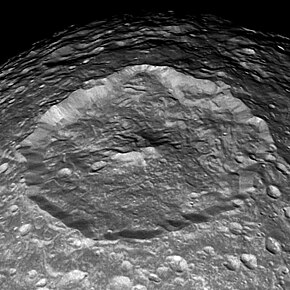Herschel (/ˈhɜːrʃəl/) is the largest impact crater on the Saturnian moon Mimas. It is located on Mimas's leading hemisphere, centered on the equator at 112° longitude. It is named after the 18th-century astronomer William Herschel, who discovered Mimas in 1789.
 An angled view of Herschel from the Cassini orbiter | |
| Feature type | Central peak impact basin |
|---|---|
| Location | Leading hemisphere, Mimas |
| Coordinates | 1°23′S 111°46′W / 1.38°S 111.76°W[1] |
| Diameter | ~139 km (86 mi)[1] |
| Depth | 10–12 km (6.2–7.5 mi)[2] |
| Discoverer | Voyager 1 |
| Eponym | William Herschel |
Geology
editHerschel is the second-largest crater relative to its parent body of any equilibrium planetary moon in the Solar System after Tethys's crater Odysseus.[3] It is so large that astronomers have expressed surprise that Mimas was not shattered by the impact that caused it. It measures 139 kilometres (86 miles)[1] across, almost one third the diameter of Mimas. Its walls are approximately 5 km (3 mi) high,[4] parts of its floor are 10–12 km (6–7 mi) deep, and its central peak rises 6–8 km (3+1⁄2–5 mi) above the crater floor.[2] If there were a crater of an equivalent scale on Earth it would be over 4,000 km (2,500 mi) in diameter – wider than Canada – with walls over 200 km (120 mi) high.
Origin
editThe impact that formed Herschel must have nearly disrupted Mimas entirely. Large chasms (termed chasmata) that may be stress fractures due to shock waves from the impact traveling through it and focusing there can be seen on the opposite side of Mimas. The impact is also suspected of having something to do with the current "Pac-Man"–shaped temperature pattern on Mimas.[4] Herschel has an estimated age of around 4.1 billion years.[5]
Media reception
editThe similarity between Mimas's appearance and the Death Star in Star Wars due to the large size of Herschel has often been noted, both in the press and in NASA/JPL press releases.[6][7] This is a coincidence, however, as the crater's similarities were not discovered until 1980 after Voyager 1 gained line of sight, three years after the film was made.[8]
See also
edit- Pharos – a similarly-sized crater on Proteus
- List of largest craters in the Solar System
- List of tallest mountains in the Solar System
References
edit- ^ a b c "Herschel". Gazetteer of Planetary Nomenclature. USGS Astrogeology Research Program.
- ^ a b Moore, Jeffrey M.; Schenk, Paul M.; Bruesch, Lindsey S.; Asphaug, Erik; McKinnon, William B. (October 2004). "Large impact features on middle-sized icy satellites" (PDF). Icarus. 171 (2): 421–443. Bibcode:2004Icar..171..421M. doi:10.1016/j.icarus.2004.05.009.
- ^ Craters on small moons such as Stickney may be comparably large [1]; the moons of dwarf planets have not been imaged.
- ^ a b "Goddard Instrument Aboard Cassini Spacecraft Sees 'Pac-Man' on Saturn Moon". Goddard Space Flight Center web site. NASA. 29 March 2010. Archived from the original on 28 December 2022. Retrieved 3 October 2010.
- ^ "Impact Crater Size-Frequency Distribution (SFD) and Surface Ages on Mimas" (PDF). 2011.
- ^ Nicholas M. Short, Sr. "Remote Sensing Tutorial". Saturn and its Moons. p. 19-18. Archived from the original on 28 August 2015.
- ^ "PIA12570: Flying by the "Death Star" Moon". NASA/JPL/Space Science Institute. 29 March 2010.
- ^ Young, Kelly (11 February 2005). "Saturn's moon is Death Star's twin". New Scientist.
External links
edit- Nemiroff, R.; Bonnell, J., eds. (24 September 1995). "Mimas: Small Moon with a Big Crater". Astronomy Picture of the Day. NASA. - featuring the Voyager 1 image
- Nemiroff, R.; Bonnell, J., eds. (8 March 2005). "Crater on Mimas". Astronomy Picture of the Day. NASA.
- Nemiroff, R.; Bonnell, J., eds. (17 May 2009). "Mimas: Small Moon with a Big Crater". Astronomy Picture of the Day. NASA. - different photo than the 1995 one with the same title, features the Cassini image
- Nemiroff, R.; Bonnell, J., eds. (11 May 2010). "Herschel Crater on Mimas of Saturn". Astronomy Picture of the Day. NASA.
- NASA Astronomy Picture of the Day: Mimas, Crater and Mountain (11 January 2017)